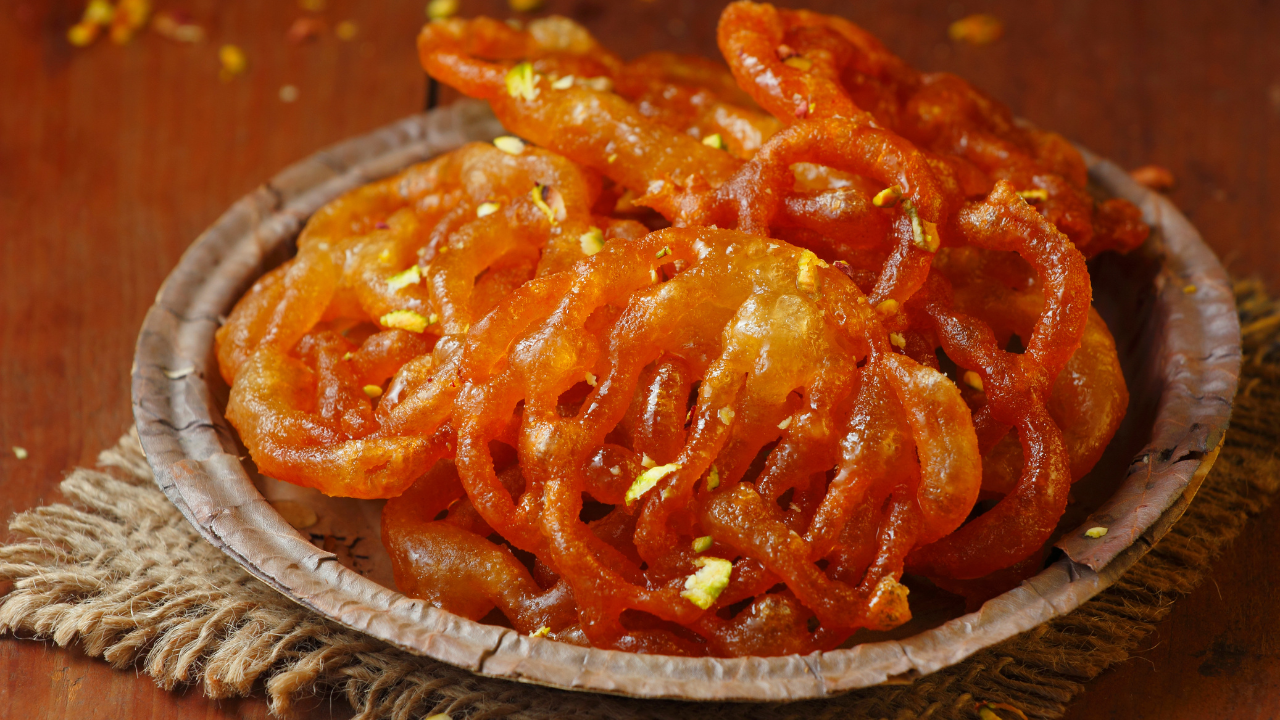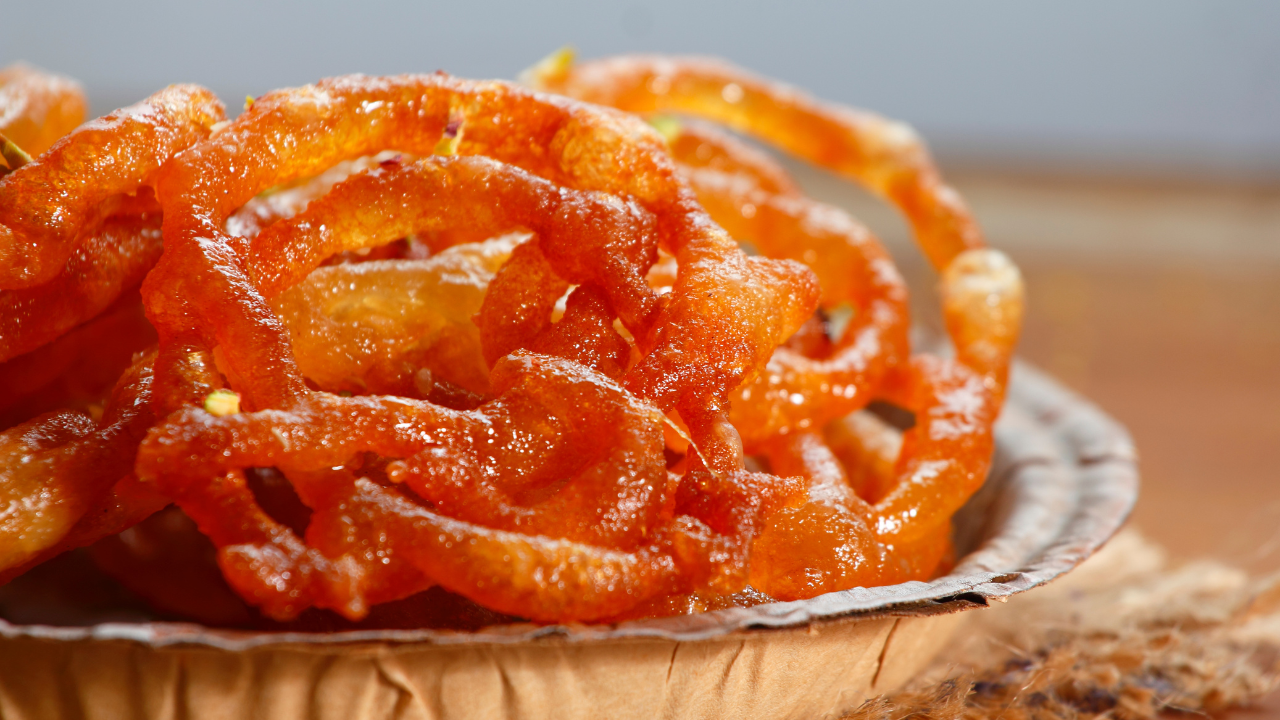
Jalebi, a spiral of golden sweetness, is a dessert that tantalizes taste buds and evokes nostalgia across South Asia and the Middle East. This crispy, syrup-soaked confection has a rich history and a timeless appeal that transcends generations.
Jalebi’s story begins in ancient Persia, where it was originally called "zalabiya." This sweet treat was a favorite among the Persians, known for its crispy texture and sugary syrup. Over time, zalabiya made its way to the Indian subcontinent, thanks to trade routes and cultural exchanges.
As it traveled, the recipe evolved, adapting to local tastes and ingredients. In India, it became known as jalebi and quickly found a special place in the hearts of the people. It wasn't just a dessert; it became a part of the social and cultural fabric.
In medieval times, jalebi was mentioned in various historical texts and cookbooks, highlighting its popularity and significance. It was not just a food item but a symbol of celebration. Whether it was a festival, a wedding, or a special occasion, jalebi was there, adding sweetness to the moment.
The making of jalebi also reflects the ingenuity and resourcefulness of ancient cooks. The process of fermenting the batter to get the right texture and flavor shows a deep understanding of ingredients and cooking techniques. This skill has been passed down through generations, making jalebi a beloved sweet treat across ages.
In summary, the journey of jalebi from ancient Persia to modern-day India is a fascinating tale of culinary evolution. Its enduring appeal lies in its unique taste and the joyous memories it brings to those who savor it.
Creating the perfect jalebi is an art that blends precision with passion, resulting in a dessert that's crispy, sweet, and utterly delightful. Here's a step-by-step guide to making this traditional treat at home.
All-purpose flour

Mixing the Ingredients: Start by combining all-purpose flour with water and a small amount of yogurt in a large bowl. The yogurt helps in the fermentation process, giving the jalebi a slightly tangy flavor.
Heating the Oil: Heat ghee or oil in a wide, flat-bottomed pan. The oil should be moderately hot, not smoking.
Dissolving the Sugar: In a separate pan, dissolve sugar in water and bring it to a boil. Add a few strands of saffron to infuse the syrup with a rich color and a delicate flavor.
Soaking the Jalebis: Once the jalebis are fried to a perfect golden hue, quickly remove them from the oil and dip them into the warm sugar syrup. Let them soak for a few minutes, ensuring they absorb the syrup.
Jalebi is best enjoyed warmly, with its crispy exterior and syrupy interior providing a delightful contrast in textures. Serve it with a side of rabri (thickened sweetened milk) or a dollop of yogurt for a balanced taste.
Jalebi holds a special place in the hearts of people across South Asia, particularly in India, where it is much more than just a dessert—it's a symbol of joy and festivity.
During Diwali, the festival of lights, households glow not just with lamps but also with the golden hues of freshly made jalebi. This sweet treat is an essential part of the celebrations. Families gather to prepare jalebi together, making it a communal activity that strengthens bonds and spreads happiness. The crunchy, syrupy spirals are often enjoyed with fireworks, laughter, and shared memories, adding sweetness to the festive atmosphere.
Eid, marking the end of Ramadan, is another occasion where jalebi takes center stage. After a month of fasting, indulging in this luscious dessert is a much-anticipated pleasure. Jalebi, with its rich, sugary syrup, symbolizes the sweetness of togetherness and the joy of breaking fast with loved ones. It's served alongside other festive dishes, making the celebrations even more delightful.
Weddings in India are incomplete without an array of sweets, and jalebi is a must-have. Its bright, cheerful appearance and delightful taste make it a favorite among wedding guests. Often, large, ornate trays filled with jalebi are part of the dessert spread, symbolizing the sweetness and joy of the union.
At fairs and markets, the sight of jalebi being freshly fried is both common and enticing. The aroma of the batter sizzling in oil, followed by the spirals being dipped in syrup, draws crowds. It's a treat that brings back childhood memories for many and offers a sense of nostalgia and comfort.
Jalebi isn't just reserved for special occasions. On a regular day, it's a popular breakfast item in many parts of India, often paired with puri (a type of bread) and spicy potato curry, balancing the sweet and savory. This combination is a beloved part of the morning routine for many, providing a burst of energy and flavor to start the day.
Traditionally, jalebi is enjoyed with a serving of rabri, a thickened sweetened milk that enhances its flavor. The cool, creamy rabri complements the warm, crispy jalebi perfectly, creating a delightful contrast. Alternatively, a dollop of fresh curd can balance its sweetness, offering a refreshing twist.
Jalebi, while undeniably delicious, is also a treat that packs quite a punch when it comes to calories and sugar content. This deep-fried dessert, soaked in syrup, is best enjoyed in moderation, especially if you’re mindful of your dietary intake.

A single serving of jalebi can contain a significant amount of calories, primarily due to the sugar syrup that it is soaked in. The sugar content gives jalebi its characteristic sweetness and sticky texture but also means that consuming it in large quantities can quickly add up in terms of caloric intake. For those watching their weight or managing conditions like diabetes, it's important to enjoy jalebi as an occasional treat rather than a regular indulgence.
Despite its high sugar content, jalebi isn’t devoid of any redeeming qualities. Traditional recipes often incorporate spices like cardamom and saffron. These ingredients not only enhance the flavor but also bring some health benefits to the table:
Given its rich and sugary nature, it’s wise to enjoy jalebi in moderation. Pairing it with something like a glass of milk or a serving of yogurt can help balance its sweetness and add a bit of protein and fat to the snack, making it slightly more balanced.
Ultimately, jalebi is a delightful treat that can bring a lot of joy, especially during festive seasons or special occasions. When eaten sparingly, it can be a wonderful part of your culinary experience without leading to significant dietary setbacks. Remember, the key to enjoying jalebi, as with many sweet treats, is moderation.
Jalebi has come a long way from its traditional form, evolving with each region and era. Each variation tells a unique story, reflecting local tastes and culinary creativity.
One popular variation is Imarti, hailing from North India. Unlike the regular jalebi, Imarti is made with urad dal (black gram) batter, giving it a distinct texture and thickness. The batter is piped into intricate flower shapes, fried to a crispy perfection, and then soaked in sugar syrup. Imarti's richer flavor and denser texture make it a favorite during festive occasions and celebrations.
In Bengal, Chhena Jalebi takes the spotlight. This variation uses fresh paneer (chhena), giving it a soft, melt-in-the-mouth quality. The paneer spirals are lightly fried and then dipped in sugar syrup, resulting in a delightful combination of crispy and soft textures. Chhena Jalebi is often enjoyed during Durga Puja and other Bengali festivals, making it a cherished part of the region's sweet offerings.
In recent years, chefs and home cooks have experimented with jalebi, giving it exciting modern twists. One such innovation is the chocolate-coated jalebi. Here, the classic jalebi is dipped in rich, melted chocolate, adding a layer of decadence to its sweet and crispy profile. This fusion dessert is a hit among chocolate lovers and is often featured in gourmet dessert menus.
Jalebi waffles are another creative take on the traditional dessert. The jalebi batter is poured into a waffle maker, creating crispy, syrupy waffles that combine the best of both worlds. Served with a scoop of vanilla ice cream or a drizzle of honey, jalebi waffles offer a delightful breakfast or brunch option, blending the familiar flavors of jalebi with the comforting appeal of waffles.
For those who love experimenting with desserts, jalebi cheesecakes are a revelation. This fusion dessert features a creamy cheesecake base topped with bits of jalebi. The tangy cream cheese pairs beautifully with the sweet, crunchy jalebi, creating a harmonious blend of flavors and textures. Jalebi cheesecakes are perfect for special occasions, adding an exotic touch to the dessert table.
Jalebi, a beloved dessert originating from ancient Persia, has traveled through time and across regions to become a staple in South Asian and Middle Eastern cuisine. Its rich history and cultural significance are celebrated during festivals like Diwali and Eid, as well as weddings and fairs. The traditional process of making jalebi involves fermenting a batter made from flour and yogurt, frying it into crispy spirals, and soaking it in saffron-infused sugar syrup.
The dessert has numerous regional variations such as Imarti, made with urad dal batter, and Chhena Jalebi from Bengal, made with fresh paneer. Modern twists include chocolate-coated jalebi, jalebi waffles, and jalebi cheesecakes, showcasing the versatility and enduring appeal of this sweet treat.
Despite its deliciousness, jalebi is high in sugar and calories, so it is best enjoyed in moderation. Traditional ingredients like cardamom and saffron add unique flavors and potential health benefits, making jalebi a delightful yet indulgent treat.
The information provided in this article is for general informational purposes only. While we strive to keep the content accurate and up-to-date, DXB News Network makes no representations or warranties of any kind, express or implied, about the completeness, accuracy, reliability, suitability, or availability with respect to the article or the information contained within. Any reliance you place on such information is therefore strictly at your own risk. Always consider your dietary needs and health conditions before indulging in any food item discussed herein.
#trending #latest #SweetSymphony #JalebiJoy #GoldenGoodness #CrispyDelight #TasteOfTradition #breakingnews #worldnews #headlines #topstories #globalUpdate #dxbnewsnetwork #dxbnews #dxbdnn #dxbnewsnetworkdnn #bestnewschanneldubai #bestnewschannelUAE #bestnewschannelabudhabi #bestnewschannelajman #bestnewschannelofdubai #popularnewschanneldubai

Sheikh Dr. Sultan bin Mohammed Al Qasimi, Ruler of Sharjah, has issued an Emiri Decree to establish and organize the Sharjah Creative Quarter (SCQ)...Read More.

Ruling BJP and allies proposed 23 changes to the Waqf Amendment Bill, while the opposition suggested 44, but none were accepted...Read More.
 Taylor Swift Stuns in ₹4.5 Lakh Louis Vuitton Jacket at Travis Kelce's Match
Taylor Swift Stuns in ₹4.5 Lakh Louis Vuitton Jacket at Travis Kelce's Match
Taylor Swift's Louis Vuitton jacket stole the spotlight as she cheered for boyfriend Travis Kelce du
 Gulf Giants Secure Six-Wicket Victory Over Sharjah Warriorz
Gulf Giants Secure Six-Wicket Victory Over Sharjah Warriorz
Tom Alsop played a brilliant knock, scoring an unbeaten 85 to lead Gulf Giants to a stunning six-wic
 Dubai's Real Estate Market Stays Among the World’s Best: Hamdan bin Mohammed
Dubai's Real Estate Market Stays Among the World’s Best: Hamdan bin Mohammed
Dubai’s real estate sector sees AED761B in transactions and 2.78M procedures in 2024
 Tamer Ashour & Adam to Perform at Al Majaz Amphitheatre on February 15
Tamer Ashour & Adam to Perform at Al Majaz Amphitheatre on February 15
Tamer Ashour & Adam to perform at Al Majaz Amphitheatre on Feb 15, promising a captivating night
 Keys Stuns Sabalenka to Win First Grand Slam Title
Keys Stuns Sabalenka to Win First Grand Slam Title
Madison Keys defeated top seed Aryna Sabalenka 6-3, 2-6, 7-5 to win her first Grand Slam title at th
Sharjah Ruler Approves Creation of Sharjah Creative Quarter

Sheikh Dr. Sultan bin Mohammed Al Qasimi, Ruler of Sharjah, has issued an Emiri Decree to establish and organize the Sharjah Creative Quarter (SCQ)
2 Non-Muslim Members Among 14 Changes in Waqf Amendment Bill

Ruling BJP and allies proposed 23 changes to the Waqf Amendment Bill, while the opposition suggested 44, but none were accepted
Exploring Dubai's Art and Culture Beyond the Skyscrapers

Discover Dubai's vibrant art and culture beyond its famous skyline.
Drug Kingpin Arrested After Wife's Social Media Reveals Location

Rodriguez shared photos at landmarks like the Eiffel Tower and Trevi Fountain, attracting DEA agents monitoring the couple's online movements
Thousands Return to North Gaza for 1st Time Since War as Israel Opens Crossings

After news of open crossings, tens of thousands of Gazans started walking north on Monday morning, carrying their belongings
Taylor Swift Stuns in ₹4.5 Lakh Louis Vuitton Jacket at Travis Kelce's Match

Taylor Swift's Louis Vuitton jacket stole the spotlight as she cheered for boyfriend Travis Kelce during the AFC Championship game
Anushka Sharma Stuns in Yellow Lehenga Worth ₹1.6 Lakh

Anushka Sharma is radiating elegance in her yellow lehenga designed by Mahima Mahajan. The stunning outfit exudes royal charm and costs ₹1.6 lakh, leaving every
Palestinian Voices Shine at Sundance Film Festival 2025

Palestinian-American director Cherien Dabis, set to shoot her personal drama *All That’s Left Of You* in the West Bank, was forced to reconsider her plans after
Colombia Reverses Deportation Decision After Trump’s Threats

Colombia agrees to accept deported citizens after Trump's tariff threat on Sunday, reversing defiance to US plans
From Underdogs to Winners: Amazing Comebacks in Sports

Discover inspiring sports comebacks where underdogs triumphed
3001E, 30 Floor, Aspin Commercial Tower, Sheikh Zayed Road, Dubai, UAE
+971 52 602 2429
info@dxbnewsnetwork.com
© DNN. All Rights Reserved.